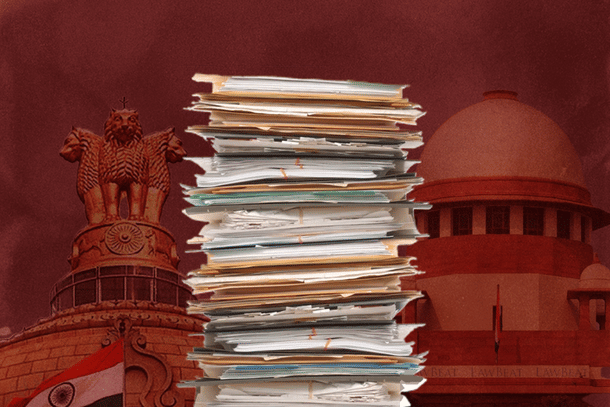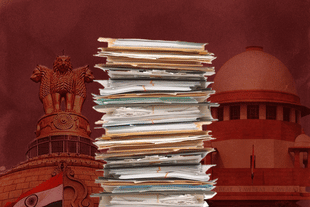Legal
Backlogged Courts — Failure Of The Judiciary Or The Government?
Diksha Yadav
Apr 08, 2025, 01:10 PM | Updated 01:15 PM IST
Save & read from anywhere!
Bookmark stories for easy access on any device or the Swarajya app.


Swarajya spoke to Nikhil Mehra, a Supreme Court lawyer, and Abhishek Dwivedi, a lawyer practising before the Lucknow Bench of the Allahabad High Court, about the various problems facing the courts in fast-tracking the huge pile of pending cases and the solutions for them on the "What This Means" podcast.
Here's an edited excerpt of the conversation.
Over 5.2 crores of cases are currently pending in courts, with the government being a major litigant in approximately 50 per cent of them. And the central government has over 6.98 lakh pending cases. Why is the very entity responsible for strengthening the judiciary system simultaneously actually straining its resources?
Many of these cases arise when a citizen disagrees with a decision made by the executive branch, often based on procedural issues rather than the substantive merits of the case. Inefficiencies and inconsistencies in the executive’s decision-making process contribute significantly to the litigation backlog.
The government’s persistence in continuing litigation — despite setbacks — often stems from concerns that not pursuing a case might set a precedent for future claims, especially in matters like pension and post-retirement benefits for various classes of employees.
The Indian state is actually quite a large apparatus. The state’s expansive role, including determining caste and your eligibility on that score, tends to determine your life prospects in terms of being able to go to university and so on and so forth. So there are a lot of decisions that the state takes which are immediately challengeable. And you'll see that there's a flood of litigation in relation to things of this sort.
On the commercial front, even when the government loses arbitration cases, it tends to appeal decisions repeatedly, further delaying resolution and execution.
The prolonged nature of the judicial process discourages individuals, businesses, and MSMEs from seeking legal redress due to the high financial, mental, and psychological toll. What's the way out for this?
There is no way out because nobody wants a way out. Look, there has to be some kind of decision-making power.
For example: If the case involves less than, say, 20 lakhs of liabilities or 50 lakhs of liabilities, no appeal is to be filed or only one appeal is to be filed. The problem that they face is that you will, in the actual case, have an army officer or a class four employee whose pension claim may be in the thousands, maybe 30,000 or 40,000, or maybe four or five lakhs. But they will say that if we lose this on principle, then that becomes a much larger claim going forward because it will affect so many more people. I am talking about cases where people are deprived of their due emoluments for decades after retirement.
However, on the bright side, for the first time last year the disposal rate of cases was much better than the filing rate, and the trend has continued this year. Last month, a total of 22 lakh cases were filed, and 31 lakh have been disposed of.
Most of these pending cases, about 85 per cent of these pending cases, are of district courts alone or the lower courts. So what are the challenges that district courts face, and how much do resources and infrastructure contribute? Do they have the bandwidth to even take up this backlog of cases?
Resource and Infrastructure Challenges: The district courts are severely under-equipped to manage the large volume of cases due to inadequate resources. Infrastructure is in a poor state, compounded by a significant shortage of judges.
Shortage and Recruitment of Judges: India has only about 20 to 24 judges per million people, in contrast to approximately 150 per million in the US and European countries. Law Commission reports recommend increasing this ratio to at least 50 judges per million, yet no substantial progress has been made.
The recruitment process for lower judiciary positions is cumbersome, often taking two to three years, with frequent cancellations of results due to procedural or cheating issues (as highlighted by a recent incident in UP).
Specialisation Issues: In cities like Lucknow, commercial courts are staffed by judges who primarily have backgrounds in other fields, such as in family law. Despite receiving academic training, these judges face difficulties adapting to the nuances of commercial law and practice.
The Arbitration Act keeps changing very quickly. So unless you are familiar or unless you have practised in the field, you'll find it very difficult to run a commercial court as presiding officers.
This mismatch undermines the intent of the Commercial Courts Act, which aims to establish specialised courts with judges experienced in commercial matters to fast-track transactions and make India a better country in terms of ease of doing business or enforceability of contracts.
Similarly, the High Court’s commercial divisions are often not segregated; instead, regular benches handle both commercial and miscellaneous cases. This dual role limits the time available to address complex commercial matters, hindering the goal of fast-tracking commercial disputes.
Economic Impact and Enforcement Issues: The delay in case disposal negatively affects the enforcement of contracts, particularly in commercial arbitration cases. Protracted litigation processes—spanning from commercial courts to appeals in Section 34, then to the High Court and eventually the Supreme Court—lead to significant delays.
Such delays disrupt cash flows and payment cycles, especially impacting MSMEs and small businesses.
Vacancy of judges—it's over 5,000 in lower courts alone. We often see that sometimes state governments put a stay on the recruitment of these judges, and other times higher courts do so. How are we failing in fulfilling the required vacancies, and to what extent does the perceived skill gap contribute to the issue?
Scale of the Problem: Estimates indicate a shortage of approximately 5,000 lower court judges, but these estimates have not been revised over time, the real deficit may be closer to 50,000.
Multiplying the current number of lower court judges by a factor of 10 might enable case disposal within one to one-and-a-half years.
Systemic Constraints Beyond Recruitment: The current examination and recruitment processes mirror other government exams and contribute to the scale gap due to inherent human capital issues.
Increasing the number of judges also necessitates corresponding improvements in infrastructure, such as additional courtrooms and supplementary staff.
Challenges in Appointments and Promotion: The judiciary continues to suffer from a notable skill gap and systemic problems in judicial appointments. The absence of comprehensive judicial and police reforms is largely due to political interests, as control over these institutions is crucial for political power.
Finding 80 competent judges for a prestigious position, such as in the Allahabad High Court, is challenging due to the stringent requirement of proven track records.
Stagnation in appointments and promotions in courts has led to career stagnation and reflects broader issues of feudal control and turf politics within the judiciary.
The Regional Disparities
While video conferencing has been successfully adopted in some states like Delhi, its benefits have not translated effectively to other states, like UP and parts of the Northeast.
Courts in states like UP are very reluctant to adopt VC. Lawyers are often asked to appear in person, and local bar associations may even bar requests for VC hearings.
Sometimes, says Abhishek, during VC hearings, judges abruptly end the session—disconnecting or muting lawyers—leaving him unable to complete his arguments. The current VC setup in some regions does not allow for the same level of judicial engagement.
Delhi also doesn't have that much of a shortage of judges, and it has a more vibrant culture. That is a tyranny of distance! In UP we feel that we are out of sight, out of mind of the Supreme Court. In non-metropolitan areas, the gap between lower courts and the Supreme Court is even more pronounced.
So, what's the solution for the huge pile of pending cases?
Apart from the government and the judges, the bar also needs to take a call. If you go to the national data grid, more than 60 per cent of the cases are pending because the lawyers took adjournments.
If you see delay reasons, over 1.41 crore cases are pending because the councils were not available. Around 62 lakh cases are pending because they are awaiting documents. About 30 lakhs are pending because parties are not interested. Some 2 lakhs are pending because there are frequent appeals or applications in the matter, and around 1 lakh cases are pending because records are unavailable.
— One of the actions the Supreme Court should take immediately is to exercise suo motu cognisance and ensure that if the government files an appeal even a day after the prescribed limitation period — whether three months, six months, or as stipulated by the Act — the appeal is automatically rejected. It should not even be allowed to be filed.
— The use of local and court commissioners in trial courts has streamlined evidence handling, reducing the duration of complex cases from years to six to eight months. This demonstrates that the system, while slow, is actively taking measures to improve efficiency.
— The video conferencing system has really helped. You can't be skipping dates anymore. And that is why pendency is coming down because disposal is going up through VCs, and judges are able to take a hearing sitting in their chambers or even at their homes or home offices at times. This is how, for example, a lot of debt recovery tribunal cases have been going on, which is perfectly fine. I don't require all the tam jham of a court. What I require is for you to be able to put your mind to the submissions that I'm making.
— Implementing a robust discovery system, where both parties must exchange all relevant evidence before litigation, could lead to more informed settlements and efficient case resolution. This approach is common in advanced judicial systems, even though such systems still experience lengthy proceedings.
— Establishing a system that continually replenishes judicial talent is crucial; this includes improving service conditions and expanding the number and quality of courts.
However, to deal with the pending cases, the following needs to be done:
Appointing a substantial number of additional judges.
Establishing dedicated benches focused solely on disposing of older cases as a potential solution.
This reform would require a coordinated effort from the government, the judiciary, and the Bar to effectively address the existing backlog.
You can listen to the complete episode on YouTube.




